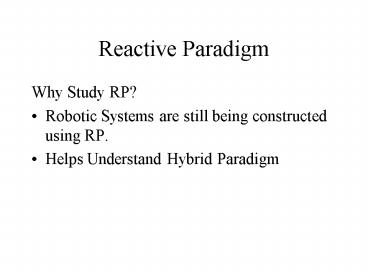Reactive Paradigm PowerPoint PPT Presentation
Title: Reactive Paradigm
1
Reactive Paradigm
- Why Study RP?
- Robotic Systems are still being constructed using
RP. - Helps Understand Hybrid Paradigm
2
Basic Difference
- HP has horizontal decomposition (HD)
- RP has vertical decomposition (VD)
- Difference between HD and VD
- In VD many processes can be performed
simultaneously. - Breathing can continue while writing, sleeping,
etc.
3
Behaviors in RPTwo approaches
- Subsumption (Brooks)
- Insect Like robots (hardware circuitory captures
behaviour) - Potential Fields (Arkin and Payton)
- Easy to implement in software
- Behaviour represented as vector, difference
vectors are summed to produce emergent behaviour.
4
Subsumption
- Behaviour a collection (network) of sensing and
acting that accomplishes the task. - Behaviours are released in a stimulus-response
way, without an external program interacting
explicitly from outside the body of the robot.
5
Aspects of Subsumption
- Layers of competence
- In these layers intelligence according to its
complexity is stored. - Basic intelligence at the lower layers.
- Modules in the upper layer can override the lower
layers - No knowledge of the localized topology is
maintained. - TASK Any appropriate layer is activated which
further activates lower layers if required.
6
Example
- Design a Robot that could move forward without
colliding. - Guess how many sensors would be required?
- How many actuators will be required?
7
Answers
- Multiple Sensors (say 10)
- At least two actuators
- Sensing SONAR BASED
- Produce a polar plot (range of sensor readings in
polar coordinates (r , theta)) - Detect when not to move forward
PowerShow.com is a leading presentation sharing website. It has millions of presentations already uploaded and available with 1,000s more being uploaded by its users every day. Whatever your area of interest, here you’ll be able to find and view presentations you’ll love and possibly download. And, best of all, it is completely free and easy to use.
You might even have a presentation you’d like to share with others. If so, just upload it to PowerShow.com. We’ll convert it to an HTML5 slideshow that includes all the media types you’ve already added: audio, video, music, pictures, animations and transition effects. Then you can share it with your target audience as well as PowerShow.com’s millions of monthly visitors. And, again, it’s all free.
About the Developers
PowerShow.com is brought to you by CrystalGraphics, the award-winning developer and market-leading publisher of rich-media enhancement products for presentations. Our product offerings include millions of PowerPoint templates, diagrams, animated 3D characters and more.

